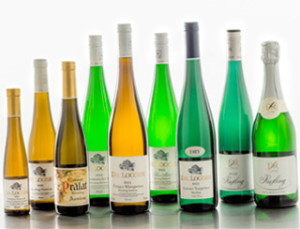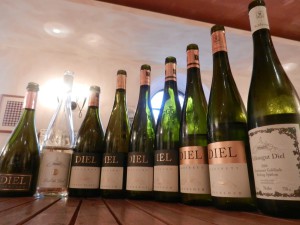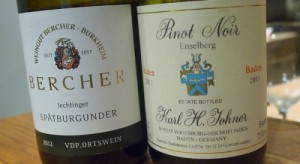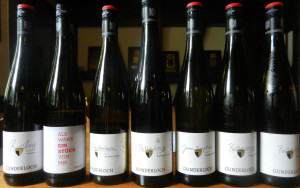The English are more and more interested in the quality German wines, especially Riesling (or simply Riesling in international terminology), nothing proves this more than the fact that their leading supermarket chains are expanding their offerings in a high pace on this front.
[CustomTables]
The local Tesco now holds 24 different German white wines, because they noticed that a particular interest can be observed towards German Rieslings in the price range over $ 2000. And what could be the reason for such popularity of the German wines? To clarify this, we have to go a little bit back to the basics, I promise it will not be too technical but very instructive.
Well, Germany is located on the northern border of viticulture, with incomparably less sunshine then, say, Italy. The result of less sunlight is that the grape plants are unable to produce so much sugar. The lower sugar produces less alcohol. And less alcohol will be the key to the solution.
It is indisputable that strong wines with a high-alcohol content are in fashion today. According to a US survey for most people more alcohol is associated with higher quality, extra added values and a better taste. But it is already known that any intensification of one-sided fashion also brings the strengthening of the opposing camp. So while many consumers lift happily a wine with more than 13-14% alcohol off the shelf, the more professional wine lovers look for lower alcohol content in more and more cases.
And at this point we arrived in Germany, who is the strongest in the 12% alcohol wine market (less sun, less sugar, low alcohol, as described earlier). And it counts more and more as a benchmark against the world of alcohol contents above 14-15%. These high values were first brought by the new-world wine producers, but soon after their extensive appearance more and more European example also reared it’s head.
It is a fact that in recent decades the sugar degrees of the harvested grapes increased everywhere, which is due to the global warming, the new plantings, the more efficient yeasts and the virus resistant vines which thus perform better. Also consider that today people no longer simply harvest when the grapes have reached a certain sugar degree, but are waiting with picking until the flavors and tannins are fully mature. The date of the delayed harvest means that the plant has more time to collect sugar, so the alcohol will be higher.
It would be difficult to decide if the wines with higher alcohol are worse or better. On the one hand the alcohol content is not important, the main thing is the balance. Thus, theoretically a wine with high alcohol is not necessarily bad if it has enough body, acid and tannin. However, opponents of the style insist on their opinion that alcohol might also suppress other delicacies, tiny nuances.
And indeed a wine with high alcohol content is undoubtedly rarely considered as elegant, thinking here mainly of the wines with 14.9 to 15.6 % alcohol content, which are not uncommon in the New World. Tastes differ, but the key to the understanding of the situation is not about voting here or there. Rather, we must realize that there is certainly a growing customer base who deliberately avoids the high alcohol wines. But if we cannot get into the mainstream, why could not we be successful with going against it?
In the next few lines you may read about the best German wines available on the market:
6. Doctor Loosen

With his face similar to Schubert and his dandy allure the globetrotter Ernst Loosen has become the privileged ambassador of German wines. Incorrigible gourmet and outstanding cook, he has at heart to offer the best wines made from the most prestigious ones of the Moselle area.
With the help of his remarkable cellar master, Bernhard Schug and the very old and non-grafted vines in the field, he produces wines with intense perfume and precision in the definition of an incomparable terroir: the Bernkasteler Lay seduce by its subtle minerality, the Wehlener Sonnenuhr by an elegant fragrance, the Ürziger Würzgarten by its spicy bouquet and the Erden wines (sumptuous Prälat) by their body and harmony.
We recommend all wines in spätlese category (dry wines to sweet) harvested beyond the usual maturity standards, since they are the most loyal to the microdifferences of the land. Ernst Loosen is also responsible in the wine Palatinate from Weingut JL Wolf where he develope stunning dry Rieslings among which the Wachenheimer Gerümpel has the very pure flavor of white peach and melon.
5. Schlossgut

The winemaker Armin Diel is also the most famous wine critic of his country. He runs with his partner Joel Payne a reference guide of German wines. No colleague would forgive him any carelessness in its vines, but it goes much further by presenting a model vineyard and wines whose finesse can hardly be surpassed.
Never before the slate hillsides of Dorsheim have produced so successful Rieslings, combining aromatic finesse and the grain of the Moselle with the vinosity of the Rhine Valley. The Goldloch vintage offers the most original bouquet, but sometimes the Pittermännchen equals or exceeds it. All the wines of these two vintages are of conventional type, low in alcohol (8°), semi-dry or sweet, but with a wonderfully balanced liquor by acidity.
This is especially true of his sublime ice wines! Diel also became famous by his dry white wines from Burgundy varieties of high undergrowth, less original and interesting for a French amateur, but we will never hesitate to consume them in the best German restaurants.
4. Fürstlich Castellsches Domänenamt

Castell-Castell is an old and prestigious German family that bears the name of his village (unless it is otherwise). Their area of 65 hectares located in Franconia never had the worldwide reputation of the great terroirs of the Rhine, because the region does not promote Riesling culture (only 6% of the area), but that of the Sylvaner grape variety, which is a less noble variety.
Too many wines have a very poor quality indeed. Yet, through careful farming, masterful winemaking and soils with high gypsum content, the sylvaner grew by domaine Castell produces more and more remarkable wines that outperform all known expressions of the same grape in Alsace or the rest of Germany.
The Cru Schlossberg and, to a lesser extent, Kugelspiel give birth to complete wines that combine liveliness, amazing and persistent vinosity, and absolutely magnificent dry spätlese and trockenbeerenauslese.
3. Karl H. Johner

The global warming is not the only possible explanation for the spectacular progress of the red wines of Baden. A handful of elite winemakers, madly in love with Burgundy, decided – with much more rigor – to grow Pinot Noir, amazingly adapted to volcanic and limestone soils of the area, and learn how to make wine from it.
At the heart of the Kaiserstuhl, little more than 50 kilometers far from Colmar, Karl Heinz Johner makes miracles with his wonderful Pinot Blancs (Weisser Burgunder) and Pinot Noirs (Spätburgunder). The millésime 2000 dominated over all it’s American, European, Australian peers during a Pinot Noir world tasting in New-Zealand a few years ago. The frame, the aromatic complexity and tannin of the SJ cuvée, the top product of the domain will surprise only those who will not see beyond the end of their nose.
2. Georg Breuer

Bernhard Breuer has devoted twenty years to the resurrection of dry wines in the Rhine Valley. It must be said that his superb vineyard on the hillside of Berg Rudesheim so dear to Beethoven favors this type of wine: because of its exposure, it is probably the driest and sunniest part of the valley.
Great admirer of French wine and culture (he is fluent in French), he became over the years a very skilled winemaker: his most successful wines (Rauenthaler Nonnenberg and Rudesheimer Berg Schlossberg) have an absolutely unforgettable crystal purity and a sharpness without aggression that makes them particularly shine on a table as a privileged companion of lobsters and langoustines.
These wines must age at least five years to bloom their incomparable mineral notes (given by the shale) and one hour of decanting before service is required. Soft and sweet wines have a crazy class because they are produced only from perfectly noble rot grapes and without any oxidation due to fermentation.
1. Weingut Gunderloch

If Fritz and Agnes Hasselbach Love to be photographed on their Harley-Davidson, their wines remain models of traditional Rieslings of the Rhine Valley, low in transformed alcohol, vinified into wine with a strong reduction and protected by the natural carbon dioxide from fermentation.
After five to six years, bitterness melts and the noble mineral bouquet of Nackenheim red soils unfolds with majesty, especially in sublime Auslese, Beerenauslese and Trockenbeerenauslese of intensity and a bite which may even shock the neophyte. The local glory of the domain never prevents the winemaker couple from perfect winemaking.
Thank you for reading our article about the best German wines. If you want to find out more about the best wines on the world, we have some other interesting articles for you about the top wines of: Uruguay, Argentina, Australia, United States, Austria and Chile. Choose your preference!
